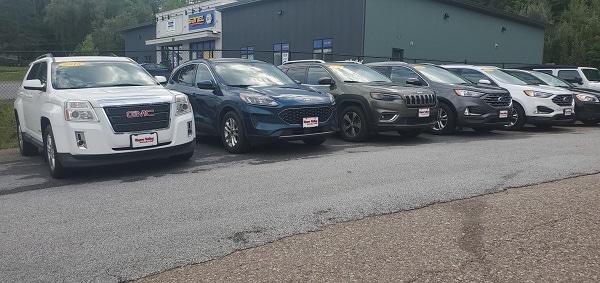Real-World Used Car Interest Rates in Vermont (H1 2025)
Real-World Used Car Interest Rates in Vermont (Jan-June 2025)
When people search for "what kind of interest rate can I expect on a used car loan in Vermont?" they usually find national averages or lender ads. Many lenders promote their lowest rates for the shortest terms, but most people either don't qualify or find the monthly payments unaffordable. This leaves them wondering what a realistic interest rate on a used car loan in Vermont might be. But at Central Vermont Auto Mart in Montpelier and Upper Valley Auto Mart in White River Junction, we crunched the numbers on dozens of used car finance deals from January through June 2025. These are real-world loans from both prime and subprime lenders - giving buyers a clear picture of what to expect when shopping for used cars for sale in Montpelier and Barre.
Vermont Interest Rate Caps
Before diving into the data, it's important to note Vermont's lending limits:
- 20% APR cap on used vehicles two model years or older
- 18% APR cap on current or one-year-old used vehicles
To help readers understand how Vermont compares, it's worth noting that usury laws-those state-specific rules that regulate maximum lending rates-vary widely across the U.S. In fact, some states do not cap APRs at all, allowing lenders considerable latitude. To put Vermont rates into perspective, some states permit rates of 30% APR or higher, while others, like Florida, allow significantly higher rates on smaller loans. Put simply: Vermont's caps-18% and 20%-are relatively consumer-friendly when compared to the highest allowable rates in the nation. This context helps underscore just how protective Vermont's regulations are when it comes to auto loan interest rates.
How We Classified Loans
After looking at a lot of data, it became obvious that lumping them all together would obscure the details. Not all "bank loans" are the same-some prime lenders make exceptions for buyers with thinner credit files, while certain national lenders serve both prime and subprime customers based on their scoring models, charging higher interest rates to subprime borrowers they choose to finance. To provide clarity, we divided loans into Prime and Subprime categories using lender identity and interest rate thresholds. This helps customers see a realistic picture of what different credit profiles are actually paying - and why understanding your credit score when buying a used car matters more than ever.
- Prime Loans → Most regional banks and credit unions, plus two national lenders where loans were under 12% APR.
- Subprime Loans → AmeriCredit, Credit Acceptance, and Global Lending Services. plus 2 national lenders where loans were above 12% APR also fall into this category.
- Special Adjustments → A credit union loan was reclassified as subprime due to its high APR and did not represent the typical standards for this lender. We also excluded used auto loans for vehicle model years prior to 2013.
Here is what the data revealed about auto loans issued between January 1, 2025, and June 30, 2025, using a used car as collateral.
Prime Loans - Averages by Model Year
| Model Year | Average APR | Average Term | Average Amount Financed |
| 2013 | 6.30% | 60 months | $13,058 |
| 2014 | 7.65% | 54 months | $16,311 |
| 2015 | 8.58% | 57 months | $16,461 |
| 2016 | 8.06% | 63 months | $17,870 |
| 2017 | 9.20% | 64 months | $17,940 |
| 2018 | 9.57% | 65 months | $19,845 |
| 2019 | 8.37% | 66 months | $22,348 |
| 2020 | 8.41% | 66 months | $18,892 |
| 2021 | 8.47% | 71 months | $23,485 |
| 2022 | 7.45% | 70 months | $25,380 |
| 2023 | 8.12% | 79 months | $33,543 |

Key Takeaway - Prime Loans
Traditionally, older cars carried noticeably higher rates. In H1 2025, that pattern flattened - the spread between a 2023 model and a 2016 model was surprisingly narrow. Buyers with strong credit saw APRs in the 5-7% range, even on vehicles 5+ years old.
Loan terms of over 72 months appeared, reflecting a trend we are seeing as buyers look for lower payments. It still represents a shorter term compared to new car loans, many of which are now being written for 84 months, with some even stretching to 96 months to help new car buyers secure affordable payments.
Lowest Prime Rate Observed: 5.15% for 48 months on a 2022 used car.
Subprime Loans - Averages by Model Year
| Model Year | Average APR | Average Term | Average Amount Financed |
| 19.49% | 30 months | $ 3,736 | |
| 2014 | 15.74% | 60 months | $15,521 |
| 2015 | 20.00% | 60 months | $12,693 |
| 2016 | 20.00% | 72 months | $23,418 |
| 2017 | 18.90% | 60 months | $10,100 |
| 2018 | 17.89% | 69 months | $19,021 |
| 2019 | 18.91% | 73 months | $20,837 |
| 2020 | 16.59% | 66 months | $18,430 |
| 2021 | 18.03% | 74 months | $20,067 |
| 2022 | 14.25% | 75 months | $26,187 |
| 2023 | 17.93% | 76 months | $28,171 |
| 2024 | 17.60% | 72 months | $21,349 |
Key Takeaway - Subprime Loans
Subprime rates cluster in the 18-19% range, but not always. Outliers stood out:
- 2014 loans averaged closer to 15.7%.
- 2022 loans came in below the typical subprime spread, showing that sometimes newer models can yield slightly better terms even with challenged credit.
Lowest Subprime Rate Observed: 12.44% for 60 months on a used car.

Rate Ranges & Real-World Examples
In a given model year, patterns became evident wherever the largest cluster of loans was observed:
Prime 2022 Models: APRs ranged 5.15% to 13.25%, with the median interest rate was 6.89%.
Subprime 2020 Models: APRs ranged 13.49% to 19.9%, while the median interest rate came in at 14.99%.
This suggests that when it comes to loan terms, individual credit profiles are more important than the age of the vehicle.
What It Means for Vermont Buyers
Whether you're shopping for a used car in the Barre - Montpelier area or the White River Junction area, based on trends so far in 2025:
- Prime borrowers should expect 5-7% rates on average, with the best loans under 5.5%.
- Subprime borrowers will likely see 18-19% rates, but some loans dip lower. There are larger range deviations in this credit subset, so be sure to work with a reputable local used car dealer to help find a loan with terms that will fit your budget.
Vermont's caps safeguard against extreme interest rates, ensuring no loans exceed legal limits. However, subprime lenders can purchase riskier, higher-interest loans in areas where charging above Vermont's cap is allowed.
At Central Vermont Auto Mart in Montpelier and Upper Valley Auto Mart, we partner with over 15 lenders - from local credit unions to national subprime specialists - to help customers find financing that fits their budget.
Summing It All Up
The first half of 2025 shows that interest rates in Vermont aren't as dependent on vehicle age as they once were. For prime buyers, the spread between a 2025 and a 2016 vehicle was narrower than expected. For subprime buyers, while most loans cluster near the cap, some lenders offered competitive deals that bucked the trend.
Bottom line: If you're shopping for a used car in Vermont, expect 5-7% if you have strong credit and 18-19% if you're rebuilding credit, with rates in between for customers that fall between prime and subprime, often times referred to as near prime credit - with real potential to land better terms depending on your lender and your vehicle choice.
Looking forward: With the Federal Reserve signaling potential rate cuts later in 2025, borrowers in Vermont could see some relief in the coming months. Any reduction in benchmark interest rates typically flows through to prime and near-prime auto loans first, lowering APRs offered by banks and credit unions. While subprime rates are less sensitive to Fed changes - since they're priced more heavily on credit risk - even those borrowers may benefit indirectly as overall financing costs ease and lenders are willing to buy deeper. For many customers, especially those on the cusp between prime and subprime, lower Fed rates could mean qualifying for a better loan tier and saving big over the life of the loan.
Want to see what rates you may qualify for today? Start your financing application online.

|
Need some help or have questions? Reach out and
let us know how we can
assist.
 Published August 28, 2025
Published August 28, 2025
